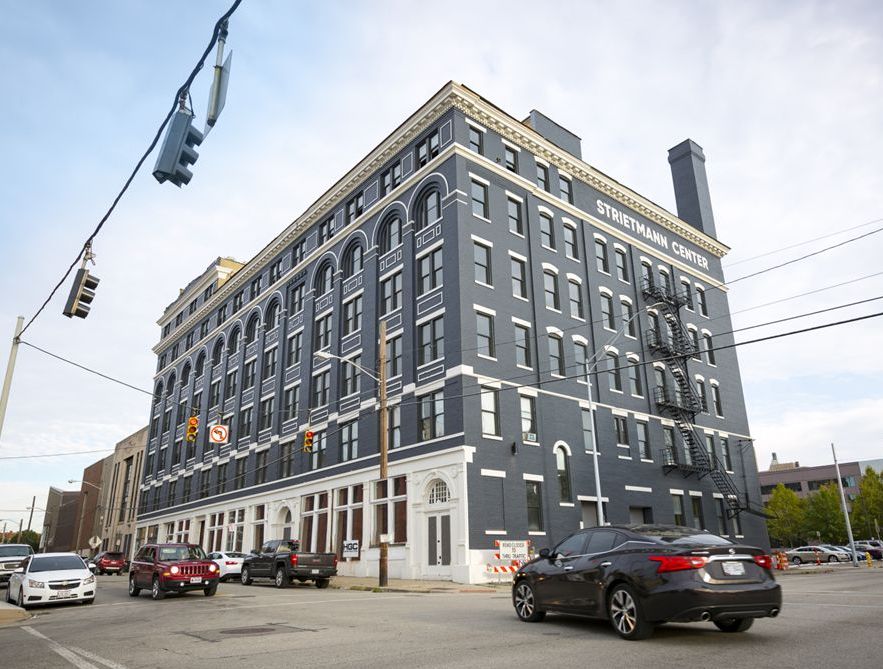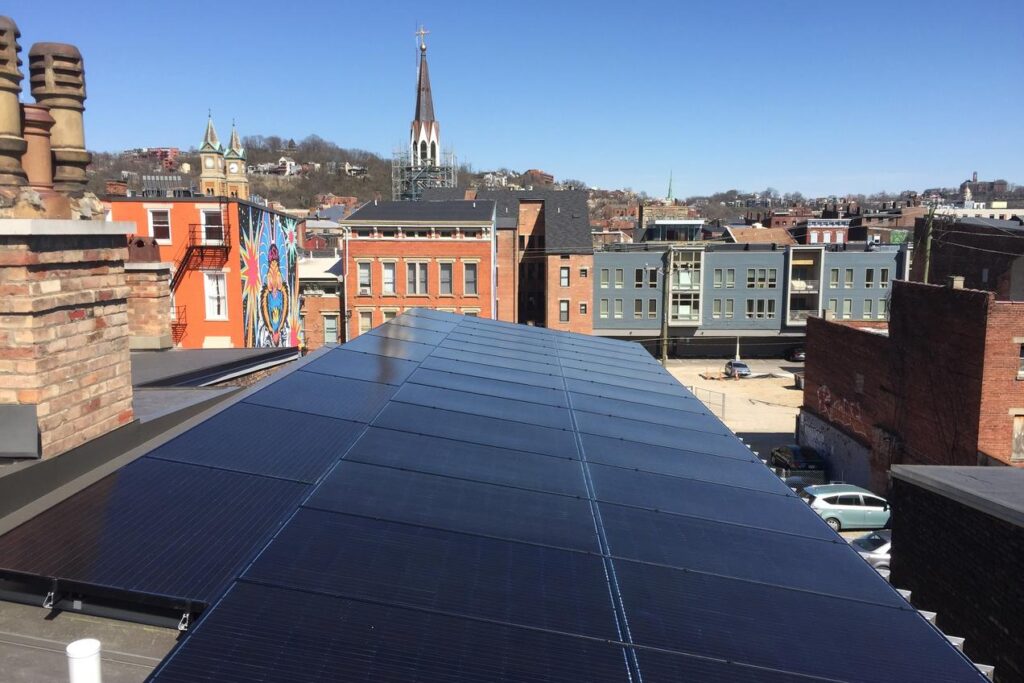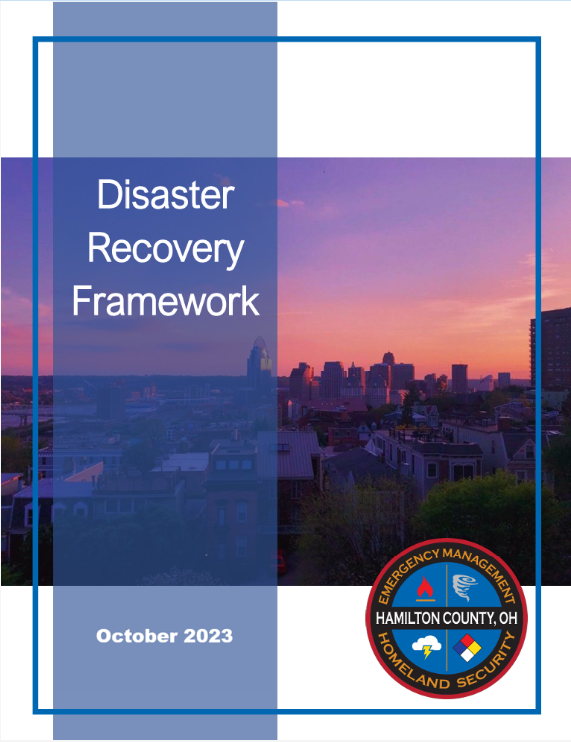Sustainability & Resilience
Sustainability in the historic preservation refers to the inherent ability of historic buildings to be reused and conserved in ways that support environmental, economic, and social resilience. As we learned at Fall Forum 2022, the greenest building is the one that’s already built. As historic preservation is the ultimate form of recycling, it is inherently a sustainable practice. Current preservation practices increasingly integrate energy efficiency improvements and climate resilience and adaptation strategies as part of a holistic approach to sustainability.
Buildings are the largest consumers of energy in the nation. In recognition of the role the built environment plays in energy use, National Park Service’s Technical Preservation Services developed guidance and technical information about how historic properties can incorporate sustainable practices to reduce energy consumption, while maintaining those characteristics that make historic properties significant.
- Weatherizing Historic Buildings
- Solar Panels on Historic Buildings
- Green Roofs on Historic Buildings
- Preservation Brief 3: Improving Energy Efficiency in Historic Buildings
Additional Resources on Sustainability:
- National Park Service Guidelines on Sustainability for Rehabilitating Historic Buildings
- Sustainability, Energy Efficiency, Resilience & Historic Buildings
- National Trust Green Stories
- Report PDF: “The Greenest Building: Quantifying the Environmental Benefits of Building Reuse”

The Strietmann Center in Over-the-Rhine received a 2017 Preservation Excellence Award from Cincinnati Preservation. The Strietmann was the 1st building in Cincinnati’s urban core to feature solar roofing.
Decarbonization of historic buildings involves reducing greenhouse gas emissions associated with their operation while preserving their cultural and architectural significance. As buildings are a major source of carbon emissions, improving the energy performance of existing structures—including historic ones—is essential to meeting building performance goals.
 In historic preservation, decarbonization focuses on:
In historic preservation, decarbonization focuses on:
- Enhancing energy efficiency through low-impact upgrades such as weatherization, improved insulation, and high-efficiency mechanical systems.
- Incorporating renewable energy where feasible and appropriate to the building’s character.
- Retaining embodied carbon by conserving existing materials and avoiding the emissions associated with demolition and new construction.
The CARE (Carbon Avoided: Retrofit Estimator) Tool is used for estimating and comparing the embodied, operating, and avoided carbon impacts and benefits of reusing and upgrading existing buildings or replacing them with new construction.
Deconstruction is the careful dismantling of buildings to salvage materials for reuse, recycling, or repurposing. Unlike demolition, which prioritizes speed and waste disposal, deconstruction emphasizes sustainability, historic preservation, and community benefit. This method is especially relevant for historic buildings, where materials often carry cultural, architectural, and environmental value.
Deconstruction involves:
- Systematically disassembling structures by hand or with minimal machinery.
- Preserving materials such as old-growth lumber, brick, hardware, and architectural features.
- Diverting waste from landfills and reducing the environmental impact of building materials.
According to Build Reuse, deconstruction contributes to the circular economy by reintegrating salvaged materials into new building projects, creating jobs, and preserving the embodied energy of historic materials.
Historic buildings often contain high-quality materials no longer available today. Deconstructing them honors the craftsmanship of the past, allowing unique materials to be reused in restoration or adaptive reuse projects and reduces carbon emissions by minimizing the need for new construction materials.
In Cincinnati, Building Value provides deconstruction services, including both full home and partial deconstruction. For over 20 years, Building Value has demonstrated the value of deconstruction to advance sustainability initiatives in the Greater Cincinnati region.
Resilience is the ability of historic places to anticipate, withstand, respond to, and recover from natural hazards—such as floods, hurricanes, wildfires, earthquakes, and severe storms. In the context of historic preservation, it means protecting the character, integrity, and cultural significance of these places while ensuring they remain safe and usable.
Historic buildings and landscapes are irreplaceable. They often contain unique materials, craftsmanship, and cultural meaning that are difficult or impossible to replicate. Many were not designed to withstand today’s intensifying natural hazards due to climate change. Ensuring their resilience helps preserve our shared heritage for future generations and maintains their continued contribution to community identity and vitality.
The Secretary of the Interior’s Standards for the Treatment of Historic Properties with Guidelines for Preserving, Rehabilitating, Restoring and Reconstructing Historic Buildings provides specific technical information on how to consider potential future impacts of natural hazards on a historic building. NPS advises that:
“Property owners of historic buildings should engage in active decision-making about how to adapt their historic buildings to be more resilient to the risks of natural hazards. Evaluation, documentation, and planning are critical for timely and purposeful decision-making. Factors including the severity and type of risk(s), economic and technical feasibility, and the historic character of the property should inform and be appropriately balanced in the decision-making process.”
Flooding and severe storms are the key natural hazard risks in the Greater Cincinnati region. The National Park Service published the Guidelines on Flood Adaptation for Rehabilitating Historic Buildings to provide information about how to adapt historic buildings to be more resilient to flooding risk in a manner that will preserve their historic character and that will meet The Secretary of the Interior’s Standards for Rehabilitation.
In the Greater Cincinnati region, planning around the Mill Creek Valley is aiming to reduce the amount of flooding along the corridor. This area is rich with historic resources, and for example, the Lower Mill Creek Watershed Action Plan included a survey of cultural resources. Proactive planning and management of these areas will help communities manage the impacts from flooding.
Getting the Words Right: A Glossary of Climate Terms (National Trust for Historic Preservation)
Resilience and Disaster Planning Resources (National Alliance of Preservation Commissions)
 Historic buildings and places are vital to community identity. After a disaster, immediate efforts should always prioritize life and safety in historic properties. However, once the response transitions into recovery, it is a critical time to provide technical and financial assistance to ensure repair efforts uplift historic places while restoring safety and functionality.
Historic buildings and places are vital to community identity. After a disaster, immediate efforts should always prioritize life and safety in historic properties. However, once the response transitions into recovery, it is a critical time to provide technical and financial assistance to ensure repair efforts uplift historic places while restoring safety and functionality.
During and after a disaster will typically include several key phases as it relates to the care of historic buildings:
- Immediate response focuses on life safety and securing the structure.
- Damage assessment after the first 1-2 weeks will involve documenting all damage and consulting with preservation professionals on stabilization and repair efforts.
- Short-term stabilization may include temporary measures such as tarping roofs or boarding windows.
- Long-term recovery provides an opportunity to integrate adaptations strategies to make the historic building resilience from future hazards.
Before and After Disasters: Guidance for State and Tribal Historic Preservation Leaders on Working with FEMA, NPS, and Other Federal Agencies (National Park Service)
Disaster Recovery Resources (National Trust for Historic Preservation)
Preservation Matters: Disasters Post-disaster Care of Cemeteries (National Park Service)
Hamilton County, OH Disaster Recovery Framework, 2023 (Hamilton County Emergency Management and Homeland Security Agency)